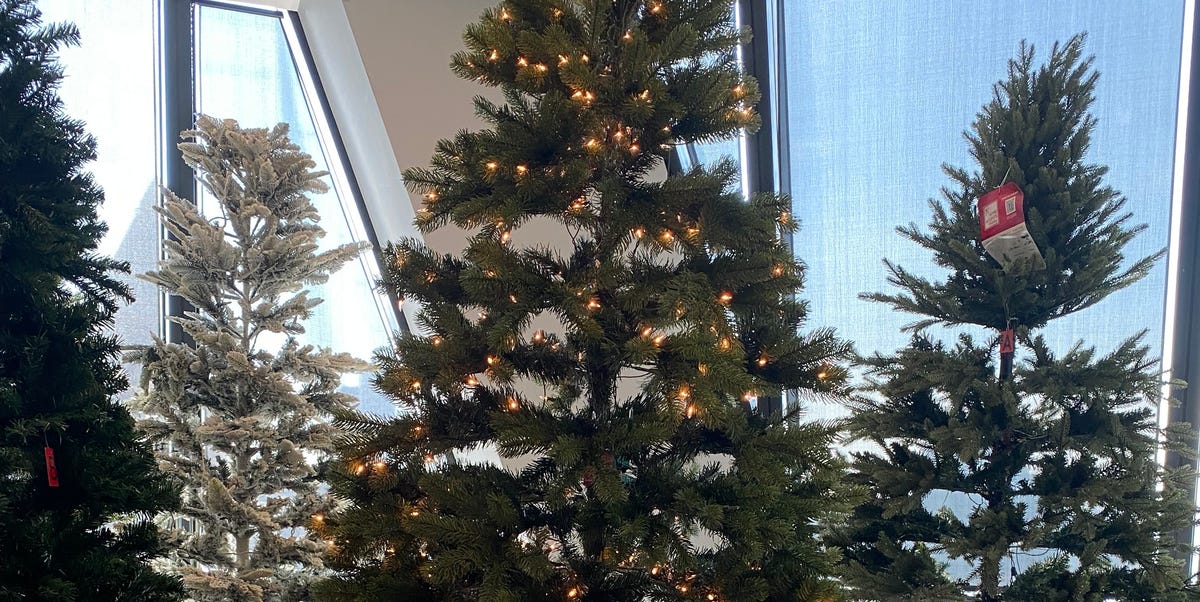| Olivia Lipski, Rachel Rothman |
Aside from ensuring the look lives up to your expectations, there are a host of other features to consider when deciding which faux tree best suits you.
✔️ Size: Trees can vary tremendously in size, from a small 4.5-foot tree to one that towers above 15 feet. While you likely want to go big with your tree, you want to make certain you will be able to set it up with enough clearance in your home. Ideally, you should keep at least 6 inches between the top of the tree (including any tree topper) and your ceiling. Also keep in mind that the larger you go, the more space your tree is likely to take up when storing it until the following season (even once disassembled). If you’re opting for a large tree, first check that you have enough storage space.
✔️ Shape: Artificial Christmas trees range from compact (for tight spaces) to full (for a classic tree profile) to wide (for an even fuller profile). While your choice largely comes down to space and preference, definitely check that the widest point of the tree will readily fit in the area you plan to set it up.
✔️ Needle type: Most brands use PVC to simulate needles and metal for the trunk and branches. Some will include both PVC and polyethylene (PE), and in general, those with a higher percentage of PE tend to look more realistic but are more expensive.
✔️ Tree type: As noted, artificial Christmas trees have come a long way in recent years to look more realistic. You can opt for a tree that mimics a fir (dense), spruce (sharp points) or pine (sparser with thin needles).
✔️ Ease of setup: Artificial Christmas trees are compressed to allow for shipping, so it’s important to fluff the branches once assembled. Today, most can be assembled by snapping together a few segments to achieve an upright tree. The fluffing often takes the most time to ensure the tree has a full appearance.
✔️ Pre-lit vs. unlit: Many artificial Christmas trees today come pre-lit, making them easier to decorate. Plus, many newer Christmas trees have the ability to stay lit even when one bulb goes out. It’s advantageous to look for this feature if you choose a pre-lit tree. The bulb type varies, and incandescent bulbs still tend to be more affordable than their longer-lasting LED counterparts. But in light of the recent incandescent light bulb ban in the U.S., some manufacturers might begin phasing out the use of these bulbs and replacing them with LED lights only. That being said, LED bulbs have the advantage of lasting longer and specialty LED trees may come with customizable color or lighting effects.
✔️ Safety: Look for pre-lit trees that have undergone third-party testing from Underwriters Laboratories (UL) to confirm they have passed safety checks. You can check the UL database or look to see if the packaging has the UL logo.
✔️ Durability: If you’re investing in a fake Christmas tree, you’ll want to opt for one that’s durable and able to last several holiday seasons. There are various industry standards that look at the durability of the tree, including ASTM B117 (corrosion test) and ASTM F963 (child safety testing). To find out whether your tree has met these standards, double-check with the manufacturer. Once set up, you’ll also want to ensure that the tree feels sturdy and isn’t subject to tipping over easily.
✔️ Price: Initially, an artificial Christmas tree is an investment, which is why it’s important to keep an eye out for Christmas tree sales, like in the summer months or during Black Friday. Trees that are larger, fuller, feature lights and have a more realistic needle type and higher tip count will likely be more expensive but are worth the extra price, thanks to their lifelike appearance and durable construction.

